1. Introduction
It is said that a bed is only as comfortable as the mattress you place on it. Given that you spend atleast a third of your day in bed, it’s important to ensure that those 8hrs are comfortable, and you feel well-rested every morning, ready to take on the challenges that lie ahead in the day. The right mattress plays a key role in making that happen.
This blog post covers 3 topics:
1. Types of mattresses
2. 9 factors to keep in mind when choosing a mattress
3. Maintaining your mattress
4. How to choose the right pillow
2. Types of mattresses
There have been significant advancements in the mattress-manufacturing space over the last decade. Mattresses today use a wide variety of materials in layers, each having its own purpose. There is rebonded foam, latex, memory foam, anti-allergy fabric, gel-infused foam, the list goes on. These materials can be stacked in different permutations and combinations with varying thickness, giving you a wide range of mattresses to choose from.
There are 4 major types of mattresses available today:
2.1 Coir mattress
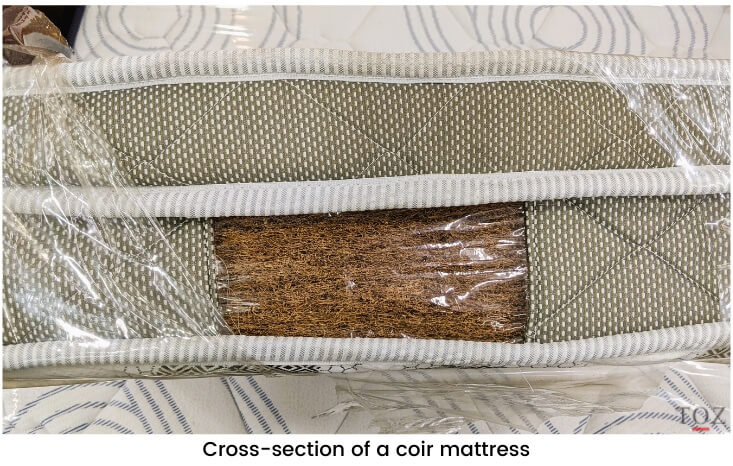
Coir mattresses have been around for ages and we all have been familiar with them since childhood. These eco-friendly mattresses are made from coconut fibre and were widely used until the early 2000s. They are firm, not too bulky, have good motion isolation and relatively inexpensive. However, they do tend to gradually sag over time and have a shorter life than the newer mattresses available today.
2.2 Spring mattress
Spring mattresses are soft, comfortable and have a nice bounce to them, making them a kids favourite. However, they are bulky and tend to sag over time as the springs lose their strength. The springs also tend to squeak after a few years of usage, which you may find irritating. Spring mattresses come in 2 types:
2.2.1 With individually wrapped springs (pocket springs)
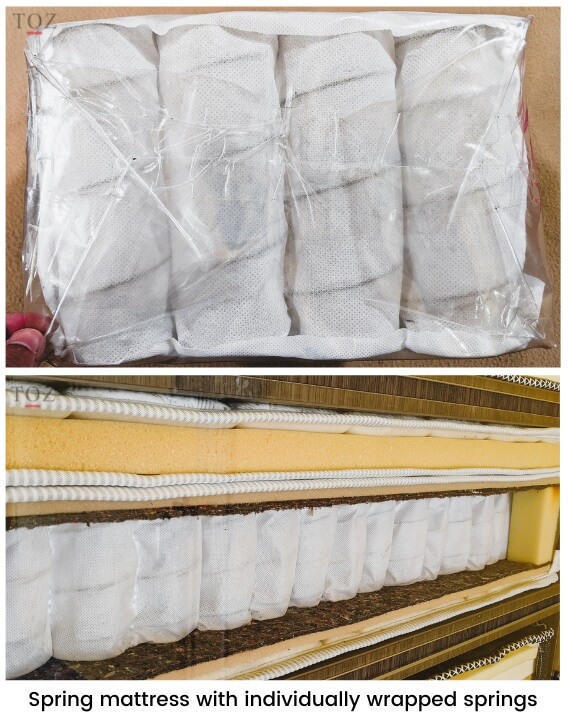
This type has individual springs arranged in a grid across the mattress. As the springs are wrapped in separate pockets, these mattresses provide good motion isolation and you are not disturbed if anyone else on the bed is changing positions.
2.2.2 With interconnected springs
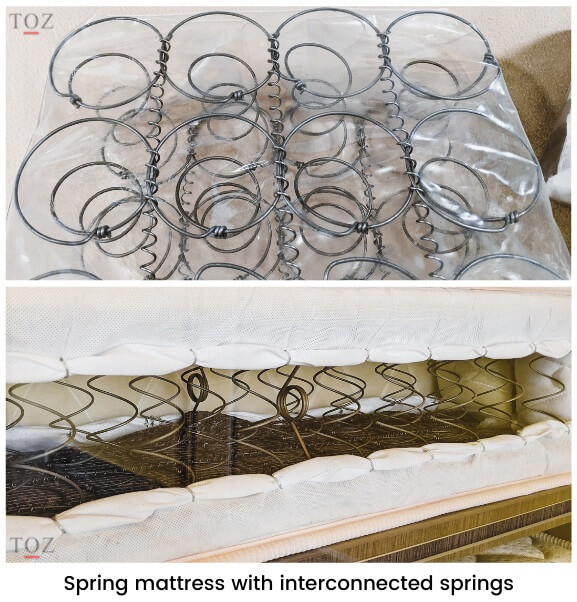
These are cheaper than the individually wrapped spring models. Since the springs are interconnected, any compression in one part of the mattress is transmitted to other parts as well. They therefore have very poor motion isolation and is best avoided if you are a light sleeper.
Personal experience:
I have used a spring mattress with inter-connected springs. It was great for the first few years before it began to sag. Motion isolation got worse and the squeaking noises got irritating. My 1-year old son would wake up every time my wife or I would turn on the bed. We would wake up groggy in the mornings with a lot of backpain. I wouldn’t recommend opting for it.
2.3 Memory foam mattress
2.3.1 Mattress structure
These mattresses generally have 2-4 layers of different types of foam of varying thickness. For ease of understanding, I’ll just group them into the base layer and the subsequent layers.
The base layer
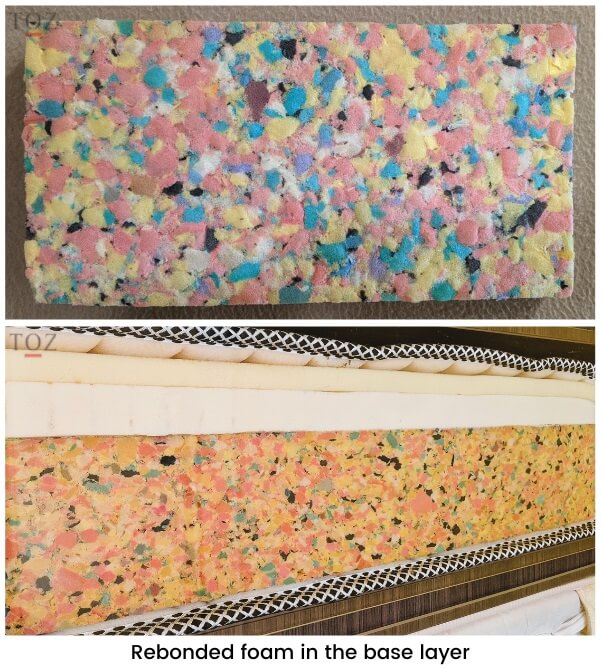
This is the most important layer as it provides support and ensures that the mattress doesn’t sag over time. This is a firm layer typically made of high-density foam or rebonded foam. Rebonded foam is the multi-coloured one you will see in stores. It is made by taking recycled shredded scraps of foam and bonding them with PU (polyurethane) under high pressure. The base layer should be atleast 4 inches thick.
Technically speaking, a higher-density of foam doesn’t necessarily translate to higher firmness, but it does make it more durable.
Subsequent layers
The base layer is followed by thinner layers of different types of foam, memory foam being the most popular. Memory foam, also called viscoelastic PU foam, is a heat activated material that softens based on the temperature of your body. The foam takes the shape of your body and gives a nice cosy feel. HR foam (high resilience) is also popular for the middle layer. It has more bounce, costs less but doesn’t last as long as the other layers.
The next layer typically is a cooling layer and uses a variety of materials like gel-infused foam or breathable foam. Different brands will have their own variations of this and market it by different names but they all serve the same function of keeping you cool during summers. Memory foam mattresses have good motion isolation, very cosy to sleep in and ideal for cooler climates.
2.3.2 Keep an eye out for
a) Too many layers
One thing to keep an eye out for is whether a mattress has too many layers. Frankly, there’s not much value added after the first 3 layers, so no point paying significantly more for additional layers.
b) Layer thickness
A single 4-inch foam is not the same as 4 layers of 1-inch foam stacked on top of each other
A single thick layer of foam has different properties and is far superior in terms of firmness compared to multiple stacked layers of the same foam. Thicker sheets of foam are more expensive to transport, so some manufacturers try to save costs by stacking multiple layers of the same foam.
2.3.3 The off-gassing issue
One of the biggest issues with foam mattresses is that of off-gassing. This is that chemical smell you get when you unpack a new mattress. These mattresses will let out different gases for a period of time. Some of these gases are known to cause headaches and allergic reactions, particularly in those people who are sensitive to smell. Off-gassing can continue for days, weeks or even months. So it is best to keep your windows open to ensure these gases don’t stay in your home environment for too long. Additionally, select a mattress that has a quality certificate showing that it complies with OEKO-TEX standard 100; this ensures that off-gassing is limited.
2.4 Natural latex mattress
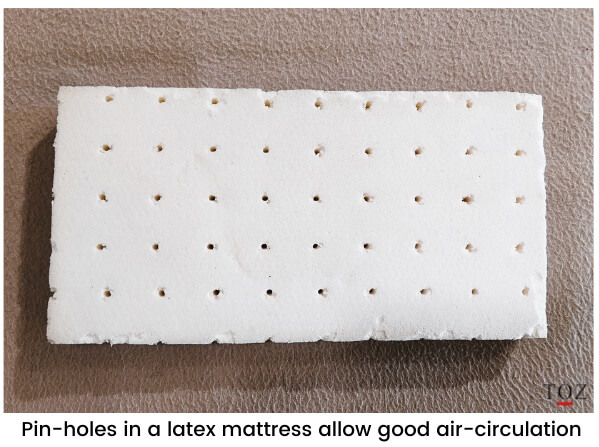
Latex mattresses are an eco-friendly option made from the sap of rubber trees. They are far superior to other mattresses in terms of durability, firmness and breathability. Consequently, they are the most expensive as well. Latex mattresses retain their firmness after several years of use, making them ideally suited for those with back pain problems. They have a good motion isolation, therefore ideal for light sleepers. The tiny pin-holes created in the mattress during the manufacturing process ensure that good air-circulation keeps you cool during summers.
If you are buying a latex mattress, make sure its natural latex and not the artificial variant.
There are 2 variants of natural latex mattresses based on the manufacturing process – Dunlop and Talalay. Dunlop is marginally more dense, firm and durable, while Talalay has slightly better cooling properties. Both are great options, and frankly, the differences are so minor that it doesn’t matter which one you select. The only disadvantage of latex mattresses is that they are heavy and a bit difficult to move around.
Personal experience:
Over the last 15 years I have used coir, spring, memory foam as well as latex mattresses and here’s what I think:
- Coir mattresses are particularly good for summers. I was living in Bombay back then, and it was the perfect fit for my needs. But are good only for the short term (approx. 4-5 years).
- The memory foam mattress is durable and really cosy, but gets a bit uncomfortable during summers. Luckily, I was living in Bangalore where it never gets too hot.
- I was initially hesitant to buy a latex mattress given its high price and was wondering if it was all hype. But after speaking to an industry expert and some friends who had used them, I decided to take the plunge. I don’t regret that decision one bit – the mattress is firm, airy, comfortable and there’s little chance I will switch back to anything else. It is difficult to explain comfort in words, so I’d suggest you check it out at one of the stores before buying.
2.5 Other of types of mattresses
There are a few other types mattresses that I have not delved into, as these are either very expensive or meant for very specific purposes. For example,
- Air-mattress can be set to any firmness level. The attached motor ensures that set pressure is maintained. However, they are extremely expensive and hence not practical for most people.
- Water-mattress or water-beds are used for patients to prevent bedsores. They are heavy and difficult to handle and can develop leaks.
Orthopaedic mattress – ideal for those with backpain
An orthopaedic mattress is not a separate type of mattress as such, it is more of a marketing term used by mattress manufacturers to address the needs of people with backpain. An orthopaedic mattress can be of any type (coir, foam, spring, latex), it is just firmer than average, that’s all. Such a mattress ensures better spinal alignment while providing pressure relief at the hip and shoulder joints. Since there is no defined standard on what the firmness of an orthopaedic mattress should be, there is quite a variation across brands. So it is better to try them out at a store or experience centre before buying.
3. 9 factors to keep in mind when choosing a mattress
A lot of people spend an inordinate amount of time on designing/buying the bed of their dreams, and they are often so tired at the end of it, that they end up buying an average mattress that is not suited for their body type and sleeping habits. In my view, a mattress is as important as a bed, if not more.
3.1 Mattress firmness
This is the single-most important factor when you are judging the quality of a mattress. A firm mattress provides the right support and ensures proper spinal alignment. Any sag can lead to a backpain. A thicker mattress is generally firmer and provides better support than a thinner one. Firmness is measured in ILD (Indentation Load Deflection), but most brands use a 10-point scale that’s easier to understand. In case you have backpain issues, consider a firm mattress. A firm mattress should not be mistaken for a hard mattress. A hard mattress can cause severe pain at pressure points and can be harmful to the body.
Never sleep on a hard mattress, it’s actually harmful for your body.
3.2 Sleeping position
The pressure distribution of the body on the mattress varies with sleeping position and hence it plays an important role in the kind if mattress that is ideal for you. For example, stomach sleepers need a firm mattress that will lift hip in line with the shoulders. Side sleepers need pressure relief on the hips and shoulders, so should prefer a softer mattress. Back sleepers need a mattress of medium firmness level.

3.3 Motion isolation
Motion isolation means that one person is not disturbed when the other person turns on the bed. If you or your partner are light sleepers or tend to toss and turn a lot at night, then choose a mattress with good motion isolation.
3.4 Edge support
Mattresses with good edge support will allow you to sleep on the edge without rolling off the bed. This is especially important if your child is young and shares the bed with you and your partner.
3.5 Load-bearing capacity
Every mattress specifies the maximum weight of a person it can support. Thicker mattresses are necessary for heavier people to ensure adequate support.
3.6 Weather
If you live in a region where temperatures are low, you could opt for a mattress that has memory foam as you tend to sink into them and they keep you warm and cosy. However, if you tend to feel hot when sleeping, opt for a mattress with higher firmness or one with good air-circulation.
3.7 Brand
Don’t blindly opt for the big brands. While some of their models are excellent, some are absolute duds in spite of being expensive. Some of the mid-size brands offer much better value. The benefit of online-only brands is that they don’t spend on real-estate for stores and pass on some of the savings to the customer.
3.8 Trial period
Some brands offer a trial period wherein you can return the mattress if you don’t like it and they provide a full refund.
3.9 Warranty
Good mattresses typically would have a 10-year warranty at the very least.
4. Maintaining your mattress
Tiny particles of dust and allergens seep through the bedsheet and accumulate in the mattress over time. The foam loses breathability and disintegrates. If you have a habit of snacking in bed, it gets worse. Mattresses are expensive and a little care can go a long way in ensuring they last for years and you wake up fresh everyday. Actually, it is more about discipline than effort.
4.1 Deep-cleaning
Get your mattress deep-cleaned every year or two. A regular deep-clean significantly increases the life of your mattress. There are home remedies as well that use baking powder along with some other solutions, but it seems like a lot of effort and so I’ve never tried them. Professional service providers are plenty and do a great job at a reasonable price. Frequency of cleaning varies between 9-24 months depending on your usage, the weather and the dust-levels in your area. Cleaning your mattress too frequently can also damage it, so keep a gap of atleast 6 months.
Get your mattress regularly deep-cleaned once every 18 months.
Personal experience:
I was never convinced about spending money on getting a mattress deep-cleaned. The first time I got it done was because a friend suggested it to me. My mattress was white and didn’t look dirty as such, even though it was 4 years old. But I was truly surprised to see the amount of dust that got extracted out. The mattress also felt fresh, softer and cooler to sleep in. Since then, I’ve made it a point to get my mattresses deep-cleaned regularly.
4.2 Waterproof mattress protector
This is a must-have if you have a child at home or have a habit of snacking in bed. Mattress-protectors are cheap and provide a great bang for your buck. You also don’t need to deep-clean your mattress that often. They come in 2 main types:
- The encasement type usually has zippers and covers the mattress on all sides. It is ideal for keeping bed-bugs away.
- The fitted type has elastic bands and is easy to remove for cleaning. Opt for this one in case you have a heavy mattress.
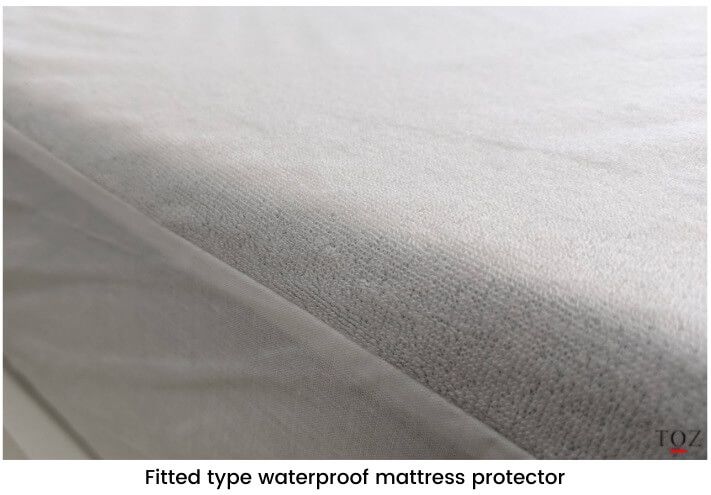
5. How to choose the right pillow
Since I receive a lot of queries from my readers on selecting the right pillow, I thought of adding add a short section on this topic.
The basic funda (principle) to keep in mind when selecting a pillow is that your spine in the neck region should remain straight while you are sleeping.
There are 4 aspects to consider when selecting a pillow:
- Fill material of the pillow
- Pillow thickness
- Pillow firmness
- Pillow Shape (Standard or cervical pillow)
5.1 Types of pillows based on pillow fill material:
There are several types of pillows based on the type of material used to fill it, but I will stick to the main four.
- Cotton pillows – These are time-tested pillows that a lot of us have used since childhood. They provide good support, but they need to be maintained properly. You need to get them fluffed up every couple of years, else they become hard. It’s also a good practice to put them in the sun regularly.
- Recron pillows – These are newer than cotton pillows and relatively cheap. They are soft and comfortable but tend to flatten over time. These often will start giving you a neck pain after a year, especially if you are a side sleeper.
- Memory foam pillows – These pillows adapt to the natural curve of your head and neck, by compressing at the right places, thereby ensuring that the spine remains straight.
- Latex pillows – These are durable pillows with good breathability. They are slightly more expensive than the memory foam ones.
5.2 Choosing a pillow based on your sleeping position:
5.2.1 Stomach sleeper
If you prefer sleeping on your stomach, opt for a soft pillow with lesser thickness.
5.2.2 Side sleeper
Firm pillows with more thickness are better suited for side-sleepers. They ensure that the neck is well-supported. You could even opt for a cervical pillow. This pillow slopes down in the centre (almost like a cut-out) and is raised in the top and bottom. The head stays ensconced in the cut-out while the raised part provides the necessary neck support. Cervical pillows are costlier than the standard pillows.
5.2.3 Back sleeper
A standard pillow with medium thickness should suffice. You can also opt for a cervical pillow.
Personal experience:
I have always been a stomach sleeper since childhood, so I was fine with thin cotton and recron pillows. However, in the last few years, I started to prefer sleeping on my back. I now sleep on my back 70% of the time and the remaining on my side. I found the standard memory foam pillow sufficient for my needs; it compresses to the right level and ensures that my neck remains straight. I also have a cervical pillow that I occasionally use – it is particularly helpful when I’ve sprained my neck and want to give it some additional support. In terms of fill material, I didn’t find much of a difference between the latex and memory foam pillows.
6. Conclusion
Buying the right mattress can make a world of a difference to the way you feel not just in the morning, but also throughout the day. With the pointers discussed above, you are much better equipped to select a mattress that’s optimally suited to the needs of your family.
Have questions or queries?
There are some pertinent queries that other readers have asked in the comments section at the end of this page; do go through them to see if any of them resonate with you. If you have a different question, feel free to mention it there; I will do my best to answer it. Please allow a few days for me to respond. If I (or any other reader) can answer it, then good. If not, atleast it will be something for the next reader to keep in mind. In case you have any learnings or experience to share, do mention it there for the benefit of other readers.
Ergonomics is important. Ergonomics is not just about the right chair, but also about the design of your desk, computer setup, lighting and the ease of access to everything you need. Given that working from home has become so prevalent now, I have written a dedicated post on how to go about designing and setting up your home office where I explore the aspects in greater detail.
In case you are planning to buy a new bed or replace your current one, you can refer to this practical guide on how to select the right bed design. It delves into 6 key aspects you must consider when buying or designing a bed to ensure that you select one that adequately fits your needs.
It’s important to co-ordinate furniture pieces and fixtures of a room in terms of size and look. If you designing your bedroom or revamping it, you may want to refer a couple of my other posts on:
- How to select the right ceiling fan for every room – this would be particularly useful in case you need a quiet fan (say, if you work from home and attend meetings) that also consumes less power.
- 4 factors to consider when designing or selecting a wardrobe – this delves into factors like build material alternatives, pros and cons of different types of shutters, designing wardrobe internals (shelves, drawers, fittings), buying readymade versus getting it custom-made.
In case you are planning to design your kitchen from scratch, you can refer my guide on planning your kitchen design that details a structured approach on how to going about it. It takes a deeper look at design and material considerations you must keep in mind for different kitchen components like cabinets, shutters, drawers, countertop, fittings, etc.
I have also written a bunch of posts on home appliances in case you are looking to buy a new refrigerator, microwave, washing machine, chimney, gas hob etc.
Share this post:

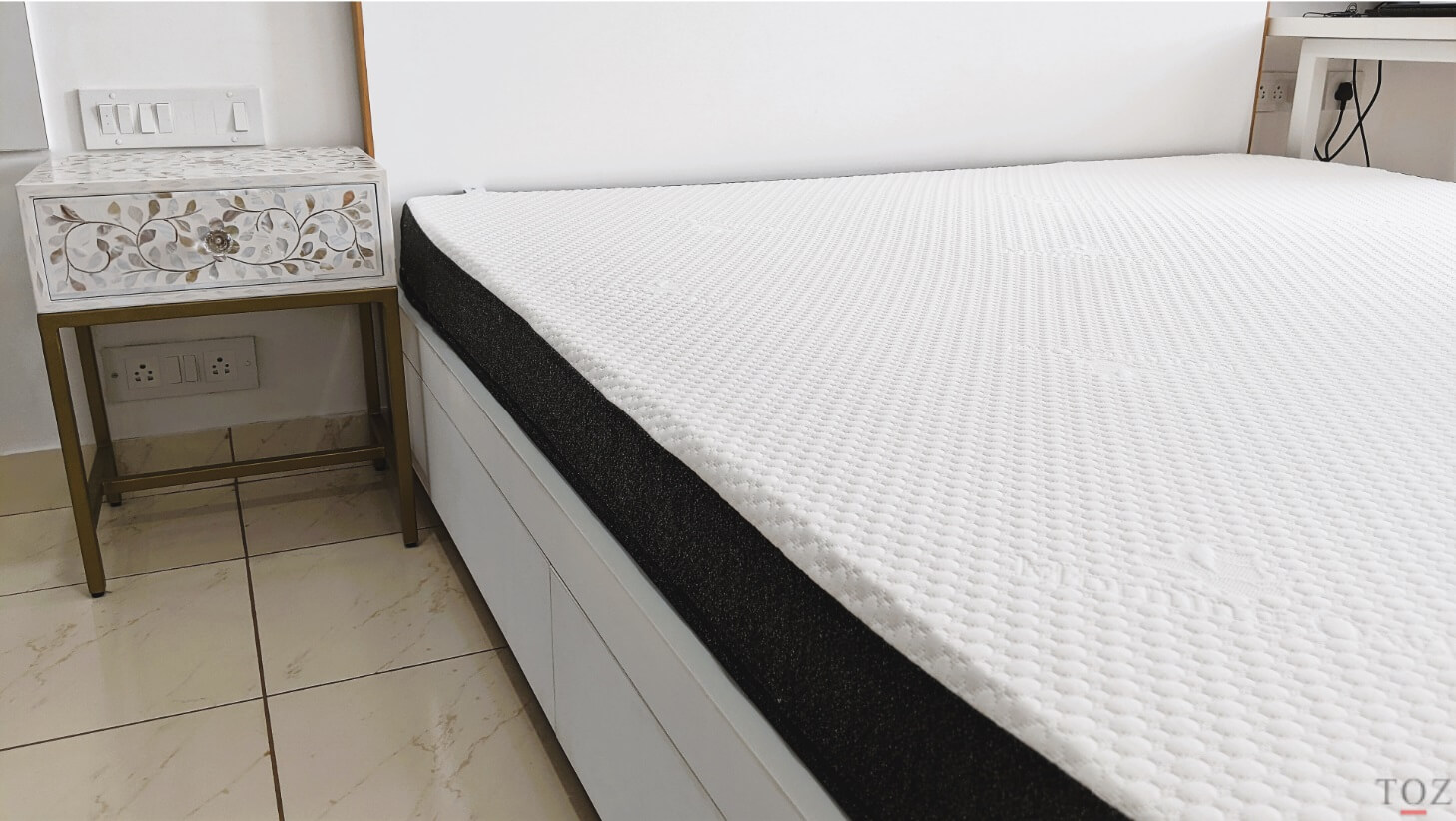




Wonderful write up, this solved my confusion in selecting a mattress
Thanks Abhishek.
Does trying out a mattress in a store really give you the right feel.. Many people like me may not be able to do a finer distinction on firmness etc and what is right .. in that case some specific recommendations on brand/products would be helpful based on your experience
Trying out a mattress in a store is actually not effective at all, even if you spend a few hours on it. The body takes time to adapt to a mattress, so you need atleast a couple of months to figure out whether the mattress is suiting you. This is the reason many of the modern mattress manufacturers give a free 100-day trial period. If you don’t like it, you can return it at no cost, provided it isn’t damaged. Do remember to read their return policy when buying. As for protecting it from damage, a waterproof mattress protector should suffice. In case you do return the mattress, you can continue using the mattress protector for the replacement mattress, as they are mostly elasticated.
Brand or model recommendations don’t help much since:
1) Mattress choice is a very personal thing. It depends on one’s personal preference of firmness level, the weather of the city you live, whether you feel hot/cold when sleeping, etc. So two people may or may not not like the same mattress. In fact, the right mattress for you could change if you move to a city with a very different weather. So take online reviews with a pinch of salt.
2) No brand is the best for all mattress types/models. While a brand may manufacture many types of mattresses, I noticed most of them focus on one or two types/models and go really deep in terms of researching and improving the product. So one brand could be better for pocket spring mattresses, the second could be for coir, the third could be for memory foam.
3) Model discontinuation is another issue. I bought this sleepwell mattress 10 years back, brilliant model. Its as good as new even today, no sagging, great support and very comfortable. But I learnt that they discontinued the model last year.
Brands and models will come and go, top-10 lists become irrelevant very quickly. Whats important is knowing what to look out for and making your own judgement, which is what I’ve tried to cover in my post.
My suggestion:
1) Consider brands that have a trial period.
2) If you are keen on getting a feel of the mattress before placing the order, go to a store. Some online-only brands have started having experience stores (just 1 or 2 in a city) where you can lie down on it and then place the order online.
3) Don’t go purely by online reviews; a lot of them are fake/paid/bot-generated. No brand’s is as bad as what some of the reviews make them out to be. If you spend some time reading these reviews, you will be able to spot them easily.
4) Another issue I see with online shopping apps is that there is no separate rating for product quality and delivery quality. So even if the product is great, a customer may give a low rating due to delayed delivery.
Great post, what would be awesome is a mattress recommender just like emi calculators 😀.. take in all parameters weather, age, lifestyle etc and recommend type of mattress. As all folks may not be able to process all the information for various reasons.
Yes, a recommender tool would be good – it could probably help arrive at a shortlist quickly. The final decision though, would still have to be made manually, given the variation of people’s preferences of firmness and what they consider to be comfortable.
I am looking to purchase a really good, durable mattress, but at the same time, I am not looking for any high end types. Not really on a memory foam mattress. I have a pretty hectic work schedule and I don’t have the time to go out and check out mattresses. I am definitely not looking for anything premium and am happy to replace my mattress after 7-8 yrs if needed. I was thinking of buying a dual comfort side mattreses. What would you suggest? Pls recommend accordingly. Thanks.
Comfort is a very subjective topic – the same mattress could be comfortable for one person and not for the other.
Since you are not able to step out, it makes most sense to opt for a dual comfort mattress. Since both sides have different firmness levels, if you don’t like one side, you can switch it to the other side. I would also suggest you look for a brand that gives you a free trial period of atleast a couple of months (do check the return policy). This way, you can exchange it for the right one if it doesn’t suit you.
Great blog. Next time when I buy a mattress, I will keep these parameters in mind.
I understood the qualitative factors and their impact, but while going for actual shopping, is it also possible to quantify these factors so that i am sure that I am making an optimal choice?
The main metric you should be looking at is the firmness of the mattress. Firmness is measured in ILD (Indentation Load Deflection). ILD is defined by how much weight is required to create an indentation in the foam by 25% of its height. Higher the ILD, the more firm the mattress is. However, most mattress companies have moved to using a 10-point scale (where 0 is very soft and 10 is very hard), as customers find this easier to understand than ILD values.
In case you are buying a foam mattress, the density of foam is also important. Higher the density, more durable the foam. Keep in mind, density is different from firmness (though there is a correlation between them). Density is measured in kg per cubic metre. For instance, if you opt for a foam mattress with rebonded foam in the base layer, try to choose rebonded foam that has a density of atleast 100 kg per cubic metre.
Dear Pradip
Your article is excellent throwing light on all aspects of selection of right mattress. I’m 63 years old. I’m more of a side sleeper. Having left shoulder pain. Since I will be changing the sides more frequently, while getting up in the morning, I get back pain. After some time, I will be alright. I intend changing my mattress. Can you please give your suggestions as to which type of mattress will be ideal for me. Your views/suggestion will be of much helpful to me in deciding a right mattress.
Hi
Conceptually speaking, you should aim for the spine to be straight while sleeping. So you need to consider both the mattress as well as your pillow in tandem. Let me address both here.
Being a side-sleeper, you should definitely avoid very firm mattresses. What happens is that your shoulder gets raised, your spine curves upwards in your neck area and you will wake up with a neck-pain next morning. Your shoulder may also get sore due to the additional pressure. A soft mattress, on the other hand, will not be good for your back.
Here’s what I think:
MATTRESS:
1) Firmness – Opt for a medium firm mattress that has above-average firmness (firmness of about 6-8 on a scale of 1-10, where 0 is very soft and 10 is very firm).
2) Type of mattress – Latex would be the best, though costly. In case you go for a foam mattress, buy one which has a thick and firm base layer (of atleast 4 inches). In case the base layer is of rebonded foam, make sure its density is above 100 kg per cubic metre). A couple of inches of memory foam above the base layer should be enough. I would avoid mattresses that are totally memory-foam – they are costlier as well.
PILLOW:
Being a side-sleeper, you should avoid thin pillows, because when you turn to your side, your head would turn downwards and you neck muscles would get strained in that position.
1) Avoid the recron pillows as they are too soft and become thin over time. No wonder they are so cheap.
2) I found the memory foam pillow ideal since it compresses to the right level and ensured that my neck remained straight.
3) Cotton pillows are good as well, but then you’ll have to maintain them.
4) Latex pillows are supposed to be good as well, though it didn’t suit me as good as the memory foam ones when I tried them.
If you have a chronic pain issue (and given your age), I would suggest you check with your doctor (either orthopaedic or physiotherapist) once before buying the mattress you select.
Here’s a Facebook comment based on the provided post:
Excellent guide!
I’m seriously considering upgrading my mattress now. Your detailed explanation of different types and factors to consider has been incredibly helpful. I’m particularly interested in memory foam for its comfort and pressure relief. However, I’m a bit concerned about potential off-gassing. Any tips on choosing a low-VOC mattress?
Also, any recommendations for mattress brands that prioritize eco-friendly materials and sustainable practices?
Thanks for sharing this informative post!
Thanks.:-).
If you want to avoid VOC, I’d recommend going for a natural latex mattress. They provide good support and last for several years. Just make sure it is natural latex and not the artificial one. A manufacturer may use artificial latex to reduce the price of the mattress. Also, make sure to check that the entire mattress is of latex and not just one of many layers. I have seen some models of brands that call it a latex mattress, only to realise that latex is just one of the 4-5 layers of the mattress. I’m sorry, but I avoid mentioning brand names as models and quality vary over time.
Reading through all the categories, it seems that a combination of memory foam with a medium firm base is well suited for a person with weak back. However i would like to know if the concept of memory foam etc is safe for children too and are there options available in the market to customise mattresses as per requirements.
Yes, memory foam is safe for children, it’s just that some people are sensitive to off-gassing. You can do 2 things to address this:
1) Start using the mattress 2 days after unpacking it, most of the gases will be gone by then. Keep a window during that time open to allow for air-circulation. Some manufacturers do this in the factory itself before packing it. But you could additionally do it at home just to be on the safe side.
2) Select a mattress that has a quality certificate showing that it complies with OEKO-TEX standard 100. This ensures that off-gassing is limited and is within safe limits right in the beginning.
We started using our mattress the same day we unpacked it and we didn’t face any issues. Nobody among my friends has faced any irritation due to it either. But statistically speaking, there is a small percentage of people who can be sensitive to it, so it’s important that I mention it.
CUSTOMISED MATTRESS
I know most of the new-age online-only brands allow you to get the mattress size customised, you just need to mention the dimensions while placing the order. These companies have bought newer machines which are equipped to manufacture any size; they just need to enter it in the system and no raw material (foam or latex) is wasted either.
Some of the older manufacturers are yet to catch-up on this front. Spring mattresses customisation is generally not available as it is very expensive to do so.
My Mom is 83. Light weight, may be between 40 & 50. Whether spring mattress will be good solution for her?
She spreads 2 layers of Jaipuri quilt over the present mattress to make the surface soft.
While to others in home it suits but Sleepwell Activa Supportec did not suit her.
Can you suggest something for her? Cost or weight of mattress doesn’t matter.
If cost doesn’t matter, I’d recommend a natural latex mattress any day.
But since your mom is quite old, I would suggest you check with your doctor (either orthopaedic or physiotherapist) once before buying the mattress you select.
Thank you Pradip,
Very insightful, and well-articulated for better understanding. Appreciate you sharing the wisdom.
Could you also shed some light on pillows? I have loved using the pillows when staying in a Hilton or Marriott, but never found similar quality/feel when buying online. Could you advise where to procure pillows that are similar to those provided in 5-star hotels?
Regards
Hi Rakesh,
Before getting into the types they used in hotels, let me first mention the 4 types of pillows you get in the market:
1) Recron pillows – They are relatively cheap, too soft and flatten over time. Often leads to neck pain after a year, especially if you are a side sleeper.
2) Memory foam pillow – I found them the best as they compress to just the right level, ensuring that my neck remains straight.
3) Cotton pillows – These are good and time-tested. But then you’ll have to maintain them, in terms putting them in the sun and getting them fluffed up every couple of years.
4) Latex pillows – They are supposed to be good as well, but somehow it didn’t suit me as well as the memory foam one.
HOTEL PILLOWS:
1) Pillows used in hotels vary a lot based on which chain of hotels you visit, especially the 5-star ones.
2) 5-star hotels also get their pillows specially manufactured from companies directly as per their brand positioning. So even if 5-star hotel uses a recron pillow, it will be far superior than what you and I get in the market.
3) Their pillows are generally large and the plush feel comes from the generous use of recron. I have come across some hotel pillows where they use a mix (eg. latex and recron) as well.
4) Since they need to varying customer needs, their pillows are generally on the softer side. They often provide pillows of varying thickness (and sometimes even size). Customers who need more thickness can stack 2 pillows one on top of the other.
I personally don’t like the super-soft pillows too much. It’s fine for a few days when I’m holidaying, but after that I prefer to return to my relatively firm one at home.
Hi Pradip,
This is a very detailed and well articulated article, thank you for this!
I wish anyone who is going crazy over mattress purchase should end up on this and they would have so much clarity after this.
Thanks Hiten 🙂
Excellent writeup Pradip. I live in the UK and was so confused by the brands/specifications offered in Indian market. There is no like for like comparison of products offered by different brands. I might have just to take a plunge and get something with exchange offer 🙂
Hi Suneel,
I’m sorry I couldn’t respond earlier, got tied up with a few things. I can relate to your confusion. It takes quite some time to arrive at the right mattress, and more so if you are visiting for short while or trying to do it remotely. If you are looking for long-term use, then I’d suggest going with a latex one from a premium brand. It turns out cheaper in the longer run.
Hi Pradip – Found your note very useful. Have been visiting stores and doing some research online as I’m trying to buy a mattress. Haven’t come across the ILD or the 0-10 scale you have mentioned….
Hi Shekar,
Most shops will not even know what ILD is. A few premium ones will use the 0-10 scale. But the bulk of them use subjective terms like soft, very soft, hard etc. And it can get very irritating as it becomes even more difficult to compare across brands and stores.